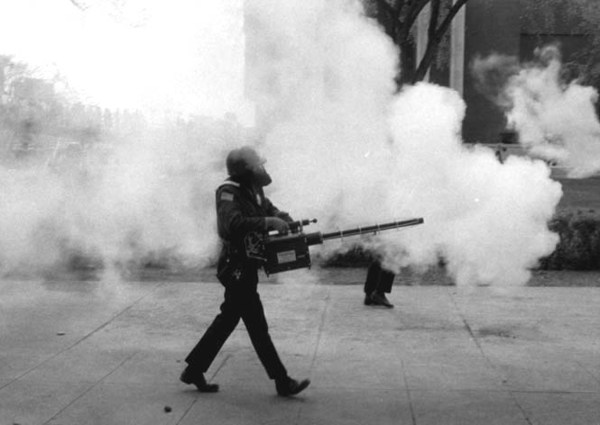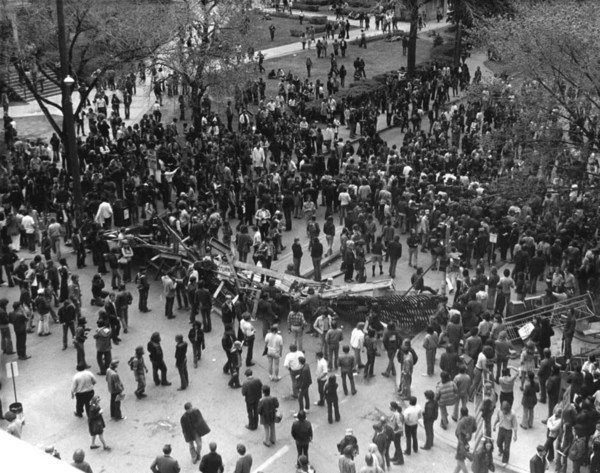Welcome back to U of M Radio on Your Historic Dial!
One of the best things about researching and writing the U of M Radio on Your Historic Dial podcast is discovering anew the fragments of history that have made Minnesota what it is today. We’ve delved into science, education, and the performing arts, among other topics, and have strived to focus on Minnesotan experiences and perspectives. Today you’re going to hear about an explosive week on the University of Minnesota campus, occurring during an era of global tension, when the political felt intensely personal, especially to students and other young people.
You can listen to the episode here in the browser and read the script below.
Podcast (umnradio): Play in new window | Download
Episode 11: Eight Days in May
Hello, this is Hannah over at University Archives, and this is episode 11 of the U of M Radio on Your Historic Dial podcast, “Eight Days in May.” Forty-five years ago this month, anti-war protests in and around the University of Minnesota boiled over as angry demonstrators and police clashed in the streets.
The audio we are going to hear on this program appeared on The Hour, a weekly program written and produced by students. This episode of The Hour aired directly after a week of protests on the U of M campus in the wake of President Nixon’s announcement on May 8th, 1972 that the United States would mine North Vietnamese ports, further escalating the conflict in Vietnam.
At first, those angered by President Nixon’s statement looked to Governor Wendell Andersen to enact measures in protest of the war’s escalation. Andersen did not do so, but was sympathetic, saying that the president’s decision was “some of the saddest news we’ve had in our lifetimes”. The first major protest began at a new housing development in Cedar-Riverside on May 9th. Two groups of demonstrators, one protesting the gentrification of the area as evidenced by the new high-rise, and the other an anti-war group, converged into a crowd of thousands. Some property damage occurred and several arrests, but this was only a prelude to the violence that would ensue the next day.
On Wednesday, the protests moved to Dinkytown, many heading to the armory, in protest of the ROTC having a presence on campus. Listeners can hear protesters chanting “USA out of Asia, Air Force out of Dinkytown” and “1-2-3-4 Vietnam’s a bosses war/ 5-6-7-8 nothing to negotiate”.

Police wearing gas masks walk through campus, attempting to disperse the crowds. University of Minnesota Archives Photograph Collection. Available at http://purl.umn.edu/71641
In what is the most unnerving segment of the broadcast, the host of the program and reporter on the ground, Larry Davenport, who graduated from the School of Journalism and Mass Communications in 1973, witnesses the tense standoff between the police and the demonstrators, giving a minute-by-minute report of the escalation of violence between the two sides. Davenport starts out near the armory, where demonstrators have constructed a barricade. The police arrive, and it soon becomes apparent that they intend to use tear gas to clear the area. The demonstrators are either resisting, throwing eggs and other small projectiles, or they are attending to wounded students. As he is running from the tear gas, Davenport reports that some protesters are throwing the gas canisters back at the police. At one point, listeners can hear Davenport coughing from gas inhalation.
By midnight, the barricade still stood, and protesters and police had come to a standstill. In considerably more peaceful surroundings, Davenport next interviews a woman who feels it is her duty to stay on the barricade, knowing it will likely not make a larger political impact.

The student-made barricade constructed on Washington Avenue on May 9th. University of Minnesota Archives Photograph Collection. Available at http://purl.umn.edu/71643
The protests continued into Thursday, with more barricades going up, which disrupted traffic to some degree. Smaller demonstrations occurred throughout the week, though none reached the fever pitch levels of Wednesday afternoon. In some instances, there was a sense of peaceful camaraderie, with groups of people singing familiar songs such as “This Land Is Your Land.” By Friday, the barricades were all dismantled.
This episode of The Hour was recorded on the Saturday following the events you’ve been listening to. In it, Davenport speculates that the protests, now sometimes referred to as the “eight days in May” or the “Dinkytown Riots”, were in part caused by the shift from dissatisfaction with the federal government for its involvement in Vietnam to outrage at the local government for deploying the police and the National Guard, some of whom were excessive in their tactics towards demonstrators.
That’s all for this episode! I hope you’ll tune in next time, when I hand the reigns over to another project archivist here in Archives and Special Collections.
The U of M Radio on Your Historic Dial podcast is produced every other week for your enjoyment. Subscribe or download on iTunes or GooglePlay so you don’t miss another moment of historic Minnesota radio.
If you enjoy our clips and want to hear or learn more, go to www.lib.umn.edu/uarchives, and search KUOM in the collection guides.
Digitization of University Archives recordings was financed in part with funds provided by the State of Minnesota from the Arts and Cultural Heritage Fund through the Minnesota Historical Society.
—Hannah O’Neill is a project archivist for the University of Minnesota Archives. To learn more about the University of Minnesota Archives, please visit www.lib.umn.edu/uarchives.





Hello,
I clearly remember, during the war protests when students created a very high pile of chairs and desks on Washington Ave in front of the Student Union, effectively stopping traffic (I was in one of the cars that had to make a U-turn on the east bound side of the Washington Ave. Bridge to go back westbound against oncoming east bound traffic. Do you have any articles from the DAILY on that incident? Was it one of the days they tear-gassed students (and did they ever teargas them from Helicopters) ?
Thank You,
Steve
Hi Steve. Thank you for your interest and your comment. It sounds like you had a first-hand experience with the events depicted in this story. The Minnesota Daily isn’t available online to view articles from this time period, however, there is microfilm available in Wilson Library or the Minnesota Historical Society. The University Archives also has a set of microfilm as well as clippings from this time.
I was a freshman and I remember the weather being unseasonably warm- you didn’t have to wear heavy coats. You could sit on the mall in the morning in the sun. I first heard of unrest when it was revealed that the Cedar Riverside Apts were going to be pricey instead of for low income people who were promised a new building if they gave up their apts there . Only a few of the apts would be low income instead of all of them.
There was a musical teach-in Tuesday night. One speaker told us of provocateurs roaming US campuses to stir up trouble -“Don’t be fooled” It was a congenial night.
I heard about trouble at the Armory on Wednesday then on Thursday 4th St traffic was being blocked. John, a bass player at my dorm, Sanford Hall gleefully told us about it.
Friday I stayed in and didn’t go to class. My friend Nathan took a camera to the Mall. He was hit by the riot police though he was sitting apart. He was taken in a wagon to be fingerprinted before being taken to the hospital with a concussion. Friday afternoon students on the Mal, leaving classes were hit by tear gas.
I did not want to return to this City after this behavior of those in charge.